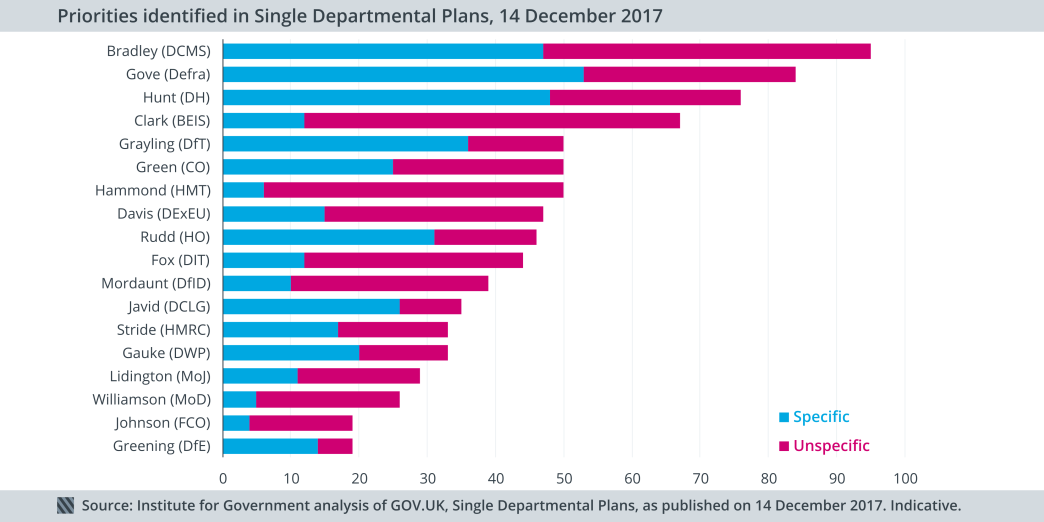Single Departmental Plans have improved but they need to go further
More focused priorities would allow departments to use their resources more effectively and allow Parliament and the public to hold them accountable.
The Government’s latest Single Departmental Plans are a huge improvement on their predecessors. But there is still some work to do to make them truly useful, argues Gavin Freeguard.
Whitehall watchers received an early Christmas present in the latest Single Departmental Plans which outline government department priorities for 2017/18. The latest plans are a great improvement on the previously published versions.
Despite their promise, and a lot of hard work by civil servants, the previous plans were a disappointment as ministers treated them like Christmas trees with every small policy bauble being hung on them. This produced an incoherent and unprioritised mess.
Many of the previous priorities were vague and impossible to measure. A particular favourite was the Foreign Office “stand[ing] up to Russian aggression whilst engaging and working with Russia where necessary”.
The Public Administration and Constitutional Affairs Committee (PACAC) said the published plans “contain[ed] too little detail on either spending or performance” and the National Audit Office said that they did “not provide all the public accountability the government said they would”.
The new versions, which arrived after a long delay caused by the election, have a new and consistent format across all departments which set out top-level objectives, sub-objectives and actions to achieve them.
They have a greater sense of prioritisation. For example, some of the Department for Education’s top-level objectives, like “close the word gap” and “close the attainment gap” are more focused.
Performance data is now listed under some objectives, for example:
- At the Ministry of Justice the objective of a “Prison and probation service that reforms offenders” are underpinned by data on prison violence, self-harm and prison officer numbers - also used in the Institute for Government's Performance Tracker.
- At the Department for Communities and Local Government the objective of “Fix[ing] the broken housing market” includes data on net additional dwellings and affordable housing completions.
- At the Department of Work and Pensions the objective of “Transforming the way we deliver our services to improve quality and reduce costs” includes data on customer and claimant satisfaction.
There are even a few cross-government objectives, from “Get[ting] the best Brexit deal for Britain" to “[Tackling] the injustices that hold people back”.
Government plans are better, but there is still room for improvement
While the new format of the Single Departmental Plans provides a sharper sense of focus and prioritisation, there are still too many priorities.

We counted 842 priorities in December 2017, down from 939 in February 2016, and that is with the net addition of one new department. The Department for Digital, Culture, Media and Sport has over 90 priorities.
Many of the departmental priorities remain unspecific – what does "a deep and special partnership" with a "smooth and orderly exit" from the European Union look like? Coincidentally, the ‘Russian aggression’ priority of the Foreign Office remains intact.
How to improve the Single Departmental Plans
The Single Departmental Plans should link priorities with a breakdown of spending by those departments, providing both the inputs and outputs in the same place. Without this basic information, it is not possible for us to measure performance or value for money.
There should also be some sense of whether the Government has the right people in place with the skills and experience to deliver these plans. How many project managers and digital experts, for example, would be needed to implement all the Government’s commitments? To make sure these people are in place, the civil service workforce strategy should reflect these departmental plans.
Sadly, the complete absence of information about people suggests that no such assessment exists.
The addition of performance data has been helpful, but not all of it is of sufficient quality. The Home Office admits there are problems with the crime data available, but it uses it in its plans anyway.
Nonetheless, the new Single Departmental Plans are more promising than their predecessors. Hopefully the next refresh of these plans will link departmental objectives with specialist skills and spending.
More focused priorities would allow departments to use their resources more effectively and allow Parliament and the public to hold them accountable.
- Topic
- Civil service
- Keywords
- Public spending
- Administration
- May government
- Publisher
- Institute for Government